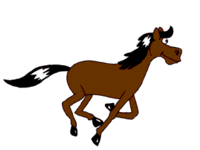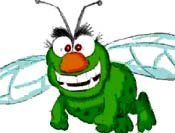Contents |
History
- Main article: History of animation
The first examples of trying to capture motion into a drawing can already be found in paleolithic cave paintings, where animals are depicted with multiple legs in superimposed positions, clearly attempting depicting a sense of motion.
The phenakistoscope, zoetrope and praxinoscope, as well as the common flip book, were early animation devices to produce movement in drawings using technological means, but animation did not really develop much further until the advent of motion picture film.
The first animated cartoon (in the traditional sense, i.e. on film) was "Fantasmagorie" by the French director ╔mile Cohl.
One of the very first successful animated cartoons was "Gertie the Dinosaur" by Winsor McKay. It is considered the first example of true character animation.
In the 1930s to 1960s, theatrical cartoons were produced in huge numbers, and usually shown before a feature film in a movie theater. MGM, Disney and Warner Brothers were the largest studios producing these 5 to 10-minute "shorts".
Competition from television drew audiences away from movie theaters in the late 1950s, and the theatrical cartoon began its decline. Today, animated cartoons are produced mostly for television.
Technologies
 A horse animated by
rotoscoping from
Edweard Muybridge's 19th century photos. The
animation consists of 8 drawings, which are
"looped", i.e. repeated over and over.
A horse animated by
rotoscoping from
Edweard Muybridge's 19th century photos. The
animation consists of 8 drawings, which are
"looped", i.e. repeated over and over.
The advent of film technology opened opportunities to develop the art of animation. The basic animation process is described in the article Animation , and the classic, hand-drawn technology in Traditional animation .
At first, animated cartoons were black-and-white and silent. Felix the Cat is a notable example.
The first cartoon with synchronized sound is often identified as Walt Disney's Steamboat Willie, starring Mickey Mouse in 1927, but Max Fleischer's 1926 My Old Kentucky Home is less popularly but more correctly credited with this innovation. Fleischer also patented rotoscoping, whereby animation could be traced from a live action film.
With the advent of sound film, musical themes were often used. Animated characters usually performed the action in "loops", i.e. drawings were repeated over and over, synchronized with the music.
Disney also produced the first full-color cartoon in Technicolor, "Flowers and Trees", in 1931, although other producers had earlier made films using inferior, 2-color processes instead of the 3-color process offered by Technicolor.
Later, other movie technologies were adapted for use in animation, such as stereophonic sound in Disney's Fantasia in 1941, and later, widescreen processes (e.g. CinemaScope), and even 3D.
Today, animation is commonly produced with computers, giving the animator new tools not available in hand-drawn traditional animation. See Computer animation for further information of the specific technologies.
Note, however, that some types of animation cannot be called "cartoons", which implies something that resembles a drawing. Clay animation and other forms of stop motion filming, are not cartoons in the strict sense of the word.
An animated cartoon created using Macromedia Flash is sometimes called a webtoon.
Feature films
The name "animated cartoon" is generally not used when referring to full-length animated productions, since the term more or less implies a "short". This section will focus on traditionally-animated feature films which would have been called cartoons had they had a shorter running time.
The first feature-length animated film (of any type) was Quirino Cristiani's traditionally-animated El Apˇstol, made in 1917 in Argentina to resounding critical acclaim and popular success.[1] That film is now lost, as is Cristiani's Sin dejar rastros, released a year later. The earliest surviving animated feature film is Lotte Reiniger's The Adventures of Prince Achmed, made in the Weimar Republic in 1926. It used intricate black paper cut-outs and scenes were tinted in various colours. However, it cannot be called a "cartoon" because it used a type of 2D stop motion animation. The first animated feature film with synchronized sound was Cristiani's 1931 traditionally-animated Pelud˛polis, which is also lost.
Disney's "Snow White and the Seven Dwarfs", made in 1937 thus holds the title of being the oldest surviving traditionally-animated feature film, the first animated feature film to use a technicolor process, and the first to be released in the United States. To date, Disney has produced 44 "Classic" hand-drawn animated features. It appears that no more will be produced, since the studio has closed all its facilities for this type of animation. They will, however, continue making computer-animated features. There have also been rumours lately that the new Pixar heads of Disney will eventually revive the studio's 2-D wing.
Other studios also produced huge numbers of animated features; a list of those released in the United States can be found here.
Notable artists and producers
Tex Avery
Ralph Bakshi
Hanna-Barbera
Quirino Cristiani
Walt Disney
Max Fleischer
Ivan Ivanov-Vano
Chuck Jones
Walter Lantz
Hayao Miyazaki
- Further information: Animation
Television
American television animation of the 1950s featured quite limited animation styles, highlighted by the work of Jay Ward on Crusader Rabbit. Chuck Jones coined the term "illustrated radio" to refer to the shoddy style of most television cartoons that depended more on their soundtracks than visuals. Other notable 1950s programs include UPA's Gerald McBoing Boing, Hanna-Barbera's Huckleberry Hound and Quick Draw McGraw, and rebroadcast of many classic theatrical cartoons from Warner Brothers, MGM, and Disney
Hanna-Barbera's show, The Flintstones was the first successful primetime series in the United States, running from 1960-66 (and in reruns since). While many networks followed the show's success by scheduling other primetime cartoons in the early 1960s, including The Jetsons, Top Cat, and The Alvin Show, none of these programs survived more than a year in primetime. However, networks found success by running these failed shows as Saturday morning cartoons, reaching smaller audiences with more demographic unity among children. Television animation for children flourished on Saturday morning, on cable channels like Nickelodeon and Cartoon Network, and in syndicated afternoon timeslots.
Primetime cartoons were virtually non-existent until 1990's hit The Simpsons ushered in a new era of adult animation.
Commercial animation
 A frame from an animated cartoon, a Finnish TV
commercial for Raid
A frame from an animated cartoon, a Finnish TV
commercial for Raid
Animation has been very popular in television commercials, both due to its graphic appeal, and the humor it can provide. Some animated characters in commercials have survived for decades, such as Snap, Crackle and Pop in advertisements for Kellogg's cereals.
The legendary animation director Tex Avery was the producer of the first Raid "Kills Bugs Dead" commercials in 1966, which were very successful for the company. The concept has been used in many countries since.
Genres of animated cartoons
Funny animals
The first animated cartoons often depicted funny animals in various adventures. This was the mainstream genre in the United States from the early 1900s until the 1940s, and the backbone of Disney's series of cartoons.
Zany humor
Bugs Bunny, Daffy Duck of Warner Brothers, and the various films of Tex Avery at MGM introduced this popular form of animated cartoons. It usually involved acts such as characters being crushed by massive boulders or going over the edge of a cliff but floating in mid air for a few seconds. The Road Runner cartoons are great examples of these actions. Disney never really mastered this genre. The article Cartoon physics describes typical antics of zany cartoon characters.
Sophistication
As the medium matured, more sophistication was introduced, albeit keeping the humorous touch. Classical music was often spoofed, a notable example is "What's Opera, Doc" by Chuck Jones. It should be noted that European animation sometimes followed a very different path from American animation. In the Soviet Union, the late 1930s saw the enforcment of socialist realism in animation, a style which lasted throughout the Stalinist era. The animations themselves were mostly for kids, and based on traditional fairy tales.
Limited animation
In the 1950s, UPA and other studios refined the art aspects of animation, by using extremely limited animation as a means of expression.
Modernism
Graphic styles continued to change in the late 1950s and 1960s. At this point, the design of the characters became more angular, while the quality of the character animation declined.
Japanese art styles
Anime became very popular among young Western adults in the late 20th century.
Animated Music videos
Popular with the advent of MTV and similar music channels, they often contain animation, sometimes rotoscoped, i.e. based on live action performers. Cartoons animated to music go at least as far back as Disney's 1929 The Skeleton Dance. These are now popular with animated band Gorillaz
See also
References
- ^ Quirino Cristiani, The Untold Story of Argentina's Pioneer Animator. AWN Magazine Article. Retrieved on April 27, 2006.
External links
- The making of an animated cartoon
- Chronology of animation
- Animated cartoons and World Day of Animated cartoon - Russian, but has a "Babelfish-translated" version.
- Best Download Cartoons




 216.73.216.81
216.73.216.81 User Stats:
User Stats:
 Today: 0
Today: 0 Yesterday: 0
Yesterday: 0 This Month: 0
This Month: 0 This Year: 0
This Year: 0 Total Users: 117
Total Users: 117 New Members:
New Members:
 216.73.xxx.xx
216.73.xxx.xx
 Server Time:
Server Time: